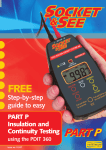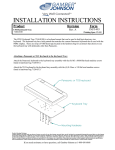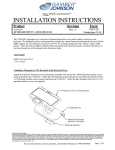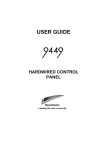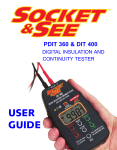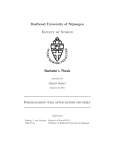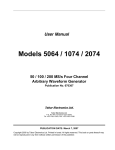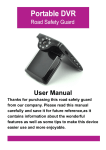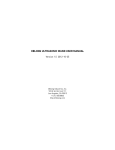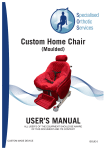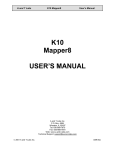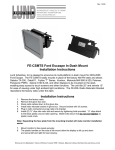Download PART P RCD Testing
Transcript
FREE Step-by-step guide to easy PART P RCD Testing using the PDRC 380 Issue no. 01/07 RCD testing What is an RCD? The initials RCD stand for Residual Current Device – so where does that get us? The dictionary tells us that the word “residual” refers to “something remaining”, so a residual current device must be concerned with something left over after two currents have been compared. In fact, the RCD is an electrical device intended to protect people and property from currents flowing incorrectly to person, which part(s) of the body in which it flows, the time for which it continues to flow and the health of the person concerned. As far as we are concerned here, the most important of these factors is the time for which the shock current is allowed to continue. If the time concerned is greater than 40 milliseconds (40 ms, which is forty thousandths of a second or one twenty-fifth of a second) there is a distinct likelihood of permanent damage to the victim, or even of their death. earth from the electrical supply. (fig 1). 1 A typical RCD in a consumer unit What does an RCD do? An RCD is a device intended to protect people from death due to RCD Unit electric shock, which usually occurs due to current flowing through them to earth (fig 2). In some cases it is used to reduce the likelihood of fire in the event of an earth fault. When an electrical circuit is healthy, the current flowing outwards through the phase conductor (often called the live conductor) is exactly the same as that returning through the neutral conductor. If current flows to earth, this current passes through the live but returns via the earth, so there is an imbalance between live and neutral currents. This imbalance is the residual current. The device will switch off quickly enough in the event of a residual current exceeding its rating to ensure that the shock victim is very unlikely to die. It must be appreciated that the RCD cannot prevent electric shocks, but can ensure the risk of the shock being fatal is considerably reduced. 2 Our standard electrical system in this country operates at a theoretical voltage of 230 volts AC (abbreviated to 230V AC) above earth potential; in fact, for historical reasons connected with a European Union decision to unify voltages, it is more likely to be in excess of 240V AC. The word “earth” in this sense should not be taken as something we grow vegetables in, but as “the general mass of earth”, or all of our surroundings, the floors, walls, metal parts in our homes and so on. In the event of an earth fault, where a live system makes contact with this “general mass of earth”, a current, known as the earth fault current, flows to earth. If this current is large enough and passes through part of a building, a water pipe for example, the heat it generates may well cause a fire. More to the point, if the earth fault current passes through a person, they will receive an electric shock. As we all know, electric shocks can be fatal; how serious they are will depend on many factors, such as the amount of electric current flowing through the Electric shock due to lack of RCD Types of RCD It would be perfectly possible to design an RCD with a rating of 1 mA, a current so low that there can be no danger of death due to The RCD can exist in a very wide variety of forms (fig 3). In some cases, it will form part of the plug used to supply an appliance (such as a hedge trimmer or a lawn mower) or it may be incorporated in the socket outlet into which the appliance is plugged. electric shock. Unfortunately, due to the fact that electrical insulation is never perfect, and another effect called capacitance, there is always a leakage current to earth of more than this value, even in a perfectly healthy circuit. Thus, an RCD with a rating as low as this would trip at once, and so would be impracticable. In other cases it may be included in the consumer unit, together with the protective fuses or circuit breakers, to protect the complete electrical installation or a part of it. Another possibility is that it is incorporated into a circuit breaker whose purpose is to protect a specific circuit. Testing RCDs It is essential to ensure that the RCD will operate as intended to prevent danger, so it must be tested. All RCDs are provided with a 3 test button (fig. 4) that should be pressed regularly by the user. This Different types of RCD system tests that the RCD will open the circuit, and does not take any account of how long it takes to operate. This test should be carried out periodically by the user and is very useful to check the basic operation of the device, but is quite useless to confirm that the user will be protected in the event of an electric shock. This test does NOT take the place of the tests we are about to explain. The PDRC 380 RCD tester is designed to measure exactly the fraction of a second taken for the device to operate in the event of a fault, which is displayed in milliseconds (ms), which are thousandths of a second. A. RCD in consumers unit B. Plug-in RCD for protection of single appliance 4 RCD Test button C. Socket outlet incorporating RCD RCD Ratings The rating of an RCD has nothing to do with its ability to handle the current to the appliance or the circuit protected, but is the value of residual current at which it will operate. Thus, an RCD in a typical domestic situation may well be able to switch off the load current of 40 A but be rated at a residual current of 30 mA (thirty thousandths of an ampere). RCDs are made with a wide range of ratings, but by far the most common are 30 mA and 100 mA. Test Button Testing 30 mA rated RCDs Caution We strongly advise reading and understanding this guide before the instrument is used. In particular note the safety issues that follow:■ Although fully protected up to 600V AC this tester is for use on 230V AC circuits only. ■ Always check the tester on a known correctly wired live socket outlet before and after use. ■ Before use - check your tester for any damage to the plug, lead and cabinet. 1. First go through the checks of voltage, polarity, and correct wiring detailed on the back cover. 2. The tester is set to 30 mA using the TRIP CURRENT button (5), when the display will show 30 mA. 3. Use the SELECT PHASE button (7) to select the positive half-cycle for test, indicated by . 4. The tests are made with the trip current set to 100% (full) rated tripping current using the SELECT TEST button (6) so that the display shows x 1 – this will be 30 mA for a 30 mA rated device. This full tripping current must not flow for more than 2 s (two seconds), and the test instrument automatically controls this requirement. The RCD should then trip within 200 ms (one fifth of a second), RCD Testing with the PDRC 380 although in the majority of cases tripping will be likely within 30 milliseconds (30 ms). 5. Repeat the test with the negative half-cycle selected using the SELECT PHASE button (7), when the symbol will be shown. Before proceeding, switch on the tester using the ON/OFF Make a note of the greater of the two trip times for record purposes. button and ensure that the orange triangle has three green LEDs 6. In the case of a 30mA RCD only, all of these tests are then repeated before proceeding. If they are not, investigation is required (see again with the test current set to 150 mA using the SELECT TEST (A) “Checking correct wiring condition of supply” on back cover). button (6), when x 5 will be displayed. Results are likely to be a Next check that the supply voltage displayed is within the limits little quicker than the previous tests, but again must not exceed of 207 to 253 V – if it is not (very unlikely), arrange for the 40 ms. Again make a note of the larger of the two trip times for customer to contact their Electricity Supply Company. record purposes. Two of these tests are necessary at each stage, with the test 7. Next select 50% (a half) of the rated tripping current using the current starting in different half-cycles of the alternating supply. SELECT TEST button (6) – this will be 15 mA for an RCD rated at Our standard supply system is alternating current at 50 Hz (Hertz), 30 mA (50mA for a 100mA RCDs). Press the TEST button (9), or 50 cycles per second. For one hundredth of a second (10ms) the when this fault current is maintained for not more than 2 s (two voltage and current are in one direction (the positive half-cycle) seconds). The RCD should NOT trip. This will be indicated by a before reversing for the same time in the negative half-cycle (fig 5). series of bleeps from the tester and a display of >2.00 s. 8. Repeat the test with the negative half-cycle selected using the 5 Positive & negative half-cycle indicators = 0˚ or (positive) =180˚ (negative) The RCD trip time can be affected by the direction of the test current, so tests must be carried out for both half-cycles. The halfcycle during which the test current is applied is chosen using the SELECT PHASE button (7), when symbols in the display will show the chosen starting half-cycle. Typically there will be a discrepancy of up to 10 ms between the two readings, and the larger of the two must be assumed and recorded for test purposes. SELECT PHASE button (7), when the symbol 2 Three LED’s show socket wiring status 7 Selects phase angle the test will start from = 0˚ or =180˚ 8 Manual or auto test sequence 9 Push to start test 4 Polarity Test will be shown. 1 On/Off button 3 Correct mains voltage indicated 5 Selects RCD rating for 30mA and100mA (I∆n) 6 Selects test to be applied x 1 Trip x 5 - Fast trip (30mA RCD only) x 1/2 - No trip RCD testing Testing 100 mA RCDs Automatic RCD testing 1. First go through the checks of voltage, polarity, and correct Whilst complete operator control is assured by the manual testing wiring detailed on the back cover. described above, it can be time consuming and is subject to 2. The tester is set to 100 mA using the TRIP CURRENT button operator error. The PDRC 380 has a unique feature that takes away the need for manual input of testing details. (5), when the display will show 100 mA. 3. Use the SELECT PHASE button (7) to select the positive halfcycle for test, indicated by . If the MANUAL/AUTO button (8) is pressed the display will 4. The previous tests are then repeated with the trip current set indicate AUTO, when the tests will be automatically selected. Press to 100% (full) rated tripping current using the SELECT TEST the TEST button (9) and note the result of your test. Reset the RCD button (6) so that the display shows x 1 – this will be 100 mA if it has tripped. Press the TEST button (9) again, and so on, until for a 100 mA rated device. This full tripping current must not the series of tests is completed. flow for more than 2 s (two seconds), and the test instrument automatically controls this requirement. The RCD should then The automatic tests carried out are:- trip within 200 ms (one fifth of a second), although in the 30 mA RCD majority of cases tripping will be likely within 30 milliseconds Use the SELECT TEST button (6) to select 30 mA. (30 ms). Make a note of the larger of the two trip times for record purposes. 5. Next select 50% (a half) of the rated tripping current using the SELECT TEST button (6) – this will be 50 mA for an RCD rated at 100 mA. Press the TEST button (9), when this fault current is automatically maintained for not more than 2 s (two seconds). The RCD should NOT trip. This will be indicated by a series of bleeps from the tester and a display of >2.00 s. 6. Repeat the test with the negative half-cycle selected using the SELECT PHASE button(7), when the symbol will be 1. Full current (30 mA) test, positive half-cycle (RCD should trip) 2. Full current (30 mA) test, negative half-cycle (RCD should trip) 3. Five times current (150 mA) test, positive half-cycle (RCD should trip) 4. Five times current (150 mA) test, negative half-cycle (RCD should trip) 5. Half current (15 mA) test, positive half-cycle (RCD should not trip) 6. Half current (15 mA) test, negative half-cycle (RCD should not trip) shown. Note that the five times current test is not required for a 100 mA RCD. 100 mA RCD Use the SELECT TEST button (6) to select 100 mA. The tests described above are manual tests, where the values to be 7. Full current (100 mA) test, positive half-cycle (RCD should trip) tested are set by the test engineer. 2 Three LED’s show socket wiring status 7 Selects phase angle the test will start from = 0˚ or =180˚ 8 Manual or auto test sequence 9 Push to start test 4 Polarity Test 1 On/Off button 3 Correct mains voltage indicated 5 Selects RCD rating for 30mA and100mA (I∆n) 6 Selects test to be applied x 1 Trip x 5 - Fast trip (30mA RCD only) x 1/2 - No trip 8. Full current (100 mA) test, negative half-cycle (RCD should trip) 9. Half current (50 mA) test, positive half-cycle (RCD should not trip) 10. Half current (50 mA) test, negative half-cycle (RCD should not trip) Note that the five times current test is not required for a 100 mA RCD. Other PDRC 380 functions The PRDC 380 does more than straightforward testing of RCDs. Its other functions are: A. Checking correct wiring condition of supply. When the instrument is first switched on by pressing the ON/OFF button, the three LEDs in the orange triangle will illuminate (fig 6) . If all is in order, all three briefly show red, changing quickly to green, back to red and then again to a steady green. This condition, showing three green LEDs, indicates the correct wiring status. Any other condition of the LEDs, together with a warbling tone, indicates a fault condition, and do not proceed with further testing. The customer should be notified of the problem, and they should seek further advice. 6 Reversal of the live and neutral/earth connections at the incoming mains supply is a very unusual, but very dangerous, fault. The PDRC 380 will test to make sure that this dangerous misconnection has not been made. To carry out the test, the orange area below the TEST button, and labelled POLARITY TEST (4) should be pressed and held for several seconds. Note that the area concerned does not depress when pushed. In the event of the three LEDs NOT being all green (fig. 8), do NOT proceed , and advise the customer to urgently contact their Electricity Supplier. 8 Correct and reverse polarity displays Correct wiring display GOOD Condition Number Wiring Condition POSSIBLE FAULT Supply Terminal N LED Display E Buzzer L Socket Wiring B. Supply voltage measurement. As soon as the three green LEDs in the orange triangle are lit steadily, the display will show the supply voltage (fig 7) . This should be compared with the correct voltage range, shown on the instrument face directly above the display. If the voltage displayed is too high or too low, the customer should seek urgent help from their electricity supplier. Do not proceed with further testing. 7 Supply voltage display C. Polarity test. 1 Correct N E L Continuous 2 L-E reverse N L E Warble 3 L-N-E miswire E L N Warble 4 L-N reverse L E N Warble 5 L-N-E miswire L N E Warble 6 Faulty N / L-E miswire NC L N Warble 7 Faulty N / E miswire NC N L Warble 8 Faulty N NC E L Warble 9 Faulty N / L-E reverse NC L E Warble 10 Faulty E / L-N reverse L NC N Warble 11 Faulty E N NC L Warble 12 Faulty E / N miswire E NC L Warble 13 Faulty E / L-N miswire L NC E Warble 14 Faulty L / N-E miswire L N NC Warble 15 Faulty L / E miswire N L NC Warble 16 Faulty L / N-E miswire E L NC Warble 17 Faulty L / N miswire L E NC Warble 18 No Mains NC NC NC None LED’s will flash to indicate fault condition NC=No Connection Socket & See Industrial www.socketandsee.co.uk Unit 4, Century Road, High Carr Business Park, Newcastle, Staffordshire, UK, ST5 7UG T +44 (0)1782 567096 F +44 (0)1782 567095 NOTE: This document is intended as a Guide to RCD Testing only and reference should be made to the PDRC380 User Manual for full operating instructions before any tests are undertaken.






